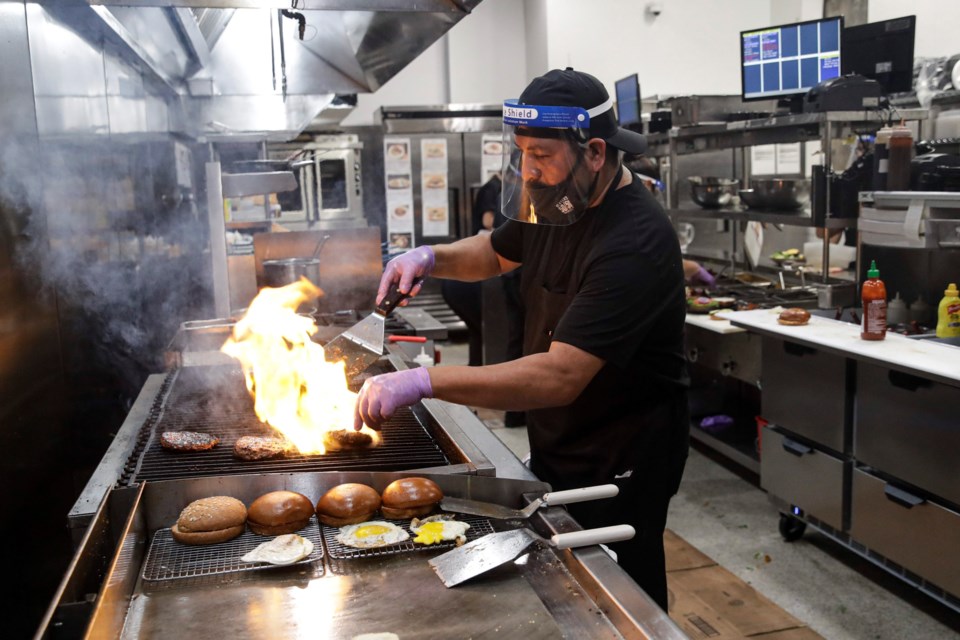LOS ANGELES — Homayoun Dariyani was training servers and cooks for his soon-to-open gourmet hamburger grill in March when California abruptly shut down dine-in restaurants to slow the spread of the coronavirus.
After a three-month delay, Dariyani held the grand opening for Slater’s 50/50 on June 18 after the state allowed restaurants to operate with limited capacity. It would be a brief reprieve.
Gov. Gavin Newsom on Wednesday shuttered indoor dining for at least three weeks across much of the nation's most populated state, warning that infections were rapidly climbing.
The sudden reversal, less than two weeks after Dariyani opened the doors of his restaurant in the Los Angeles suburb of Santa Clarita, left him stunned and in a financial fix. He had stockpiled fresh beef and produce for a busy Fourth of July weekend, which now could turn into a five-figure loss.
He’s struggling — again — to keep 60 workers on the payroll with nearly 300 seats inside his restaurant empty. He has a takeout window and room for 80 on his patios, where customers are allowed to eat because the threat of virus transmission is much lower outdoors.
The latest order “is a huge step back for all the restaurants,” said Dariyani, who also runs a catering business. “It’s not fair to anybody.”
The coronavirus crisis has left millions unemployed, but few businesses have been hit as hard as California's estimated 90,000 restaurants. Industry experts predict that as many as one-third of them will never reopen, while others are trying to navigate a maze of new sanitation rules and physical-distancing guidelines that have gutted seating charts and boosted in-house costs.
“It’s chaos,” said Jot Condi, who heads the California Restaurant Association.
California had been successfully managing the virus, and through May, Newsom moved quickly to reopen much of the economy. But troubling signs emerged in mid-June and have only worsened. Confirmed cases and hospitalizations have skyrocketed, and Newsom took action this week to try to reverse the trend.
The Democratic governor also shuttered bars, movie
The latest order was especially painful for those in the restaurant industry who believed they did everything right, investing heavily in staff training and gloves, masks and other supplies to meet health restrictions.
At critically acclaimed Guerrilla Tacos in Los Angeles, chef-owner Wes Avila had just reopened Wednesday after two weeks of employee training for pandemic-era food service. Now, like Dariyani, he has to come up with a new plan.
“There’s not like a consultant you can hire to fix this,” Avila said.
When the outbreak began, Avila was forced to downsize from more than 50 employees to four and change to takeout and delivery. When he reopened as a sit-down restaurant, he brought back employees and even hired new ones, going up to 46 people.
Now, he’s worried he’ll have to halve his staff after Newsom blocked indoor dining in 19 counties.
Many owners believed they had become part of the solution when dining resumed last month, with limited seating, one-use paper menus and teams of mask-wearing employees routinely sanitizing tables, bathrooms and other surfaces.
Restaurants were required to establish a COVID-19 prevention plan, assess the risk at all work areas and designate a person to oversee safety procedures.
“We haven’t seen evidence that suggests these cases are from restaurants,” said Condi, referring to the surge in new infections.
That was echoed in the state Senate by Republican Leader Shannon Grove from Bakersfield, who lamented that many of the darkened restaurants are small businesses run by families.
There’s “no data showing it's restaurants” driving up virus cases, she said.
But health officials have tied outbreaks to restaurants, including 14 cases in San Diego County in the last week. In Los Angeles, with its internationally lauded food culture, health officials have visited thousands of restaurants to check for compliance with masks and social distancing rules. In many cases, inspectors found problems.
In Orange County, a succession of restaurants have temporarily closed after one or more employees were infected with COVID-19.
For most people, the coronavirus causes mild or moderate symptoms, such as fever and cough, that clear up in two to three weeks. For some, especially older adults and people with existing health problems, it can cause more severe illness and death.
Even with capacity limited to 60%, business had been brisk for Dariyani during his brief run with indoor dining.
He faulted the state for moving too fast to reopen businesses, then ordering them to reverse course with no warning. In a resigned voice, he acknowledged that “government has to do what it has to do."
Can he make it financially with his indoor dining room closed?
“Definitely not," Dariyani said. But he intends to try. "What is the other option?”
___
Associated Press writers Stefanie Dazio in Los Angeles, Adam Beam in Sacramento and Julie Watson in San Diego contributed.
Michael R. Blood, The Associated Press

